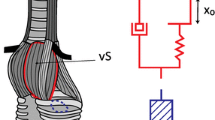Abstract
Output analysis and input-output experiments had given evidence for five sequential effects occuring independently of each other in the singing behavior of blackbirds (Fig.1). Recently these investigations resulted in a model which summarized the interaction of five functional components evaluated from the found effects; thereby the model explained the data processing controlling the sequential patterning of the behavior (Fig. 2) — During the investigations reported here, this model and alternative models were tested by means of computer programs. Main question: Would the models generate sequences of patterns equivalent to the sequence of vocal patterns produced by a blackbrid? Results:
-
1)
Only the original one of the tested models generated sequences of patterns showing the specific regularities and their characteristic variations corresponding to natural blackbird songs. This brought evidence for a multiplicative mode of interaction between the “component of throttling-back” (Drosselungskomponente) and the other four components; furthermore for a terminal functioning of the “extreme-value-passage” (Extremwertdurchlaß) (Figs, 2–4 and 10).
-
2)
Concerning the “component of periodicity” (Periodikkomponente) the mechanism of a “reset of periods” was falsified while the mechanism of a “continued periodicity” could be made evident. This implied: The periodicity of the single pattern (phrase) runs over the course of the whole song: the proceeding of the oscillation takes place with each output realisation (Fig. 5).
-
3)
Variations of values of the particular parameters given to the different components during the testing programs showed that a) extreme values resulted in “unnatural” sequences of patterns; b) only values lying within distinct intervals generated sequences containing the whole set of the postulated effects; c) exactly with those parameter values, with which one of the effects could get produced in a natural form, also the other effects were generated correspondingly optimal (Figs. 6–8).
-
4)
The differential variation of the values of the particular parameters given to the components (during the testing programs) allowed a lot of predictions concerning the consequences of increasings or decreasings in the strength of the different components. These predictions have to be tested by experiments with natural systems (blackbirds) (Fig. 9; Tables 1–3).
Similar content being viewed by others
Literatur
Clausen,A.: Putzaktivität beim Haubenmainah. Behaviour, im Druck (1974/75)
Hassenstein,B.: Kybernetik und biologische Forschung. Handbuch der Biologie, Frankfurt: Athenaion 1966
Hauske,G.: Ein elektronisches Funktionsmodell für Verhaltensweisen eines Fisches. Kybernetik 3, 27–33 (1966)
Heiligenberg,W.: Zum Wechselgesang der Heimchen. Kybernetik 1968. München: Oldenbourg 1968
Hinde,R.A.: Alternative motor patterns in Chaffinch song. Anim. Behav. 6, 211–218 (1958)
v.Holst,E.: Relations between the central nervous systems and the peripheral organs. Anim. Behav. 2, 89–94 (1954)
Isaae,D., Marler,P.: Ordering of sequences of singing behaviour of Mistle Thrushes in relationship to timing. Anim. Behav. 11, 179–188 (1963)
Lemon,E.R., Chatfield,C.: Organization of song in cardinals. Anim. Behav. 19, 1–17 (1971)
Mittelstaedt,H.: Strategien und Methoden der analytischen Kybernetik. Kybernetik 1968. München: Oldenbourg 1968
Thimm,F.: Sequentielle und zeitliche Beziehungen im Reviergesang des Gartenrotschwanzes. J. comp. Physiol. 84, 311–334 (1973)
Thimm,F., Clausen,A., Todt,D., Wolffgramm,J.: Zeitabhängigkeit von Verhaltensmusterfolgen. J. comp. Physiol. 93, 55–84 (1974)
Todt,D.: Zur Steuerung unregelmäßiger Verhaltensabläufe. In: Mittelstaedt,H. (Hrsg.): Ergebnisse einer Analyse des Gesangs der Amsel. S. 465–485. Kybernetik 1968. München: Oldenbourg 1968
Todt,D.: Gesangliche Reaktionen der Amsel auf ihren experimentell reproduzierten Eigengesang. Z. vergl. Physiol. 66, 294–317 (1970a)
Todt,D.: Äquivalente und konvalente gesangliche Reaktionen einer extrem regelmäßig singenden Nachtigall (Luscinia megarhynchos L.). Z. vergl. Physiol. 71, 262–285 (1971c)
Todt,D.: Biologisch-kybernetische Analyse der Komposition des Gesanges verschiedener Vögel. In: Lueken,B., Scharf,H.J. (Hrsg.): Nova acta leopoldina, Neue Folge Nr. 208, Bd. 37/2, S. 311–331 (Neue Ergebnisse zur Informationsaufnahme und Informations-verarbeitung in Sinnesorganen). Leipzig: J. A. Barth 1973
Todt,D.: Short term inhibition of vocal outputs occuring in the singing behavior of black birds. J. comp. Physiol. (im Druck)
Wolffgramm,J.: Lautmustersequenzen und periodische Beziehungen im Rollerkanari-Gesang (Serinus canaria). J. comp. Physiol. 85, 65–88 (1973)
Author information
Authors and Affiliations
Rights and permissions
About this article
Cite this article
Todt, D., Wolffgramm, J. Überprüfung von Steuerungssystemen zur Strophenanwahl der Amsel durch digitale Simulierung. Biol. Cybernetics 17, 109–127 (1975). https://doi.org/10.1007/BF00363950
Received:
Issue Date:
DOI: https://doi.org/10.1007/BF00363950




